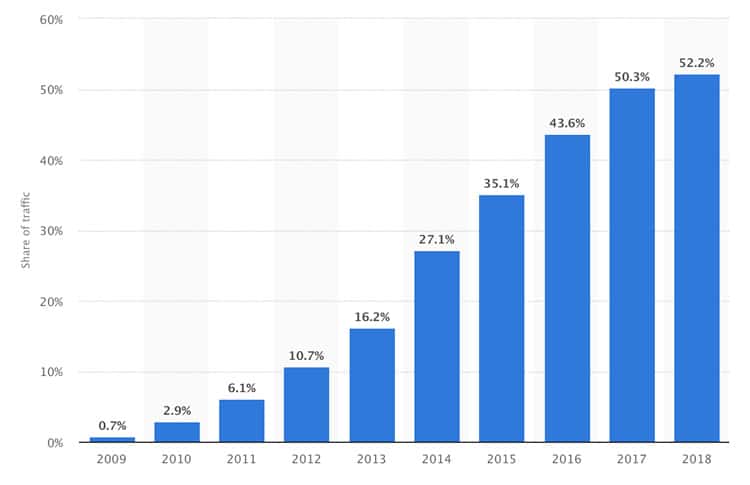
Every couple of days, search engines update their algorithms and marketers respond by forming new SEO guidelines. So as technology continues to advance, SEO strategy needs to adapt ever faster. Instead of trying to keep up with the whims of Google’s web crawlers, companies need to start future-proofing their SEO and usability strategies.
That starts with recognising which SEO principles are constants. These pillars of search engine rankings include:
- Crawlability: How easy is it for the search engine find your content?
- Website Structure: How is the search engine prioritising your web content?
- Keywords: What is your content all about?
- Backlinks: How does the search engine understand that your content provides trustworthy information?
No matter how many times Google retools their algorithm, no matter how many more people browse exclusively on mobile, no matter how many new voiced-based UI‘s begin to infiltrate everyday life, these will remain constant. Now that we have a stable foundation for our SEO strategy let us move on to the latest trends that should influence it.
Google’s New Mobile Algorithm For SEO
Mobile browsing has been increasing at a steady clip for years. Just in 2018 so far, mobile browsing accounts for fifty-two per cent of all Internet browsing.

In March of 2018, Google officially introduced mobile responsiveness as one of the factors in your websites search ranking. Google does not have two (one for mobile and one for desktop), but every website’s index will factor in the mobile instance of the site, to help cater to Google’s primary users.
If your site is not optimised for mobile devices, you are genuinely falling behind. Not only are you missing out in sales, and user engagement, but starting this year, your users may not even be able to find your website if the mobile usability is not up to par.
What Google’s Updated Algorithm Means For You
The updated algorithm means that if your website does not deliver one consistent user experience across all screen sizes, devices, and viewports, Google will penalise you in their rankings, and new users may have trouble finding your website.
Similar to all of Google’s mysterious algorithms, they do not disclose the exact calculation of website responsiveness as an SEO factor. However, they do offer a mobile-friendly guide, a tool to test your mobile speed, and a mobile-friendly test.
Pass these tests, and tick these checkboxes on Google’s guides, and your website should be ready to earn points in Google’s rankings.
The Rise Of Voice-Based User Interfaces
The dominance of voice-based user interfaces (VUIs) is on the rise and have been in the public consciousness for years, especially since the launch of Siri in 2011.
According to Google, 72% of people who own a voice-activated device say that it is part of their everyday routine. Google also stated that 52% of people keep their voice-activated device in their living room so that it is in the centre of their home and anyone can use it.

Voice-based interfaces are widely used to ask questions ranging from “What’s the weather in Chicago today?” to “What time is it in London right now?” However, in the recent years, this new technology has a more significant impact on search behaviour, because people like the convenience of it.
How Will VUIs Force You To Change Your SEO Strategy?
With the increase of voice-based searches, user experience designers have to take in new considerations for VUI’s, and digital marketers have to optimise their search strategy to be effective on different devices like an Alexa, Google Home, and even Siri.
The usability of VUI devices will be top-notch for searches only if Alexa can find the right information. Customers using voice search are looking for a direct answer. This means you need to keep all of your information on your business up-to-date, and that your content is precise and directly answers conversational questions. Your content should also coincide with long-tail keywords for voice search inquiries so that the search engines can quickly scan it to find and deliver the most accurate but easy-to-find answer.
One easy way to incorporate this into your website is to have an FAQ section on your website or application. This way, you will not be awkwardly adding ‘direct answers’ to your content.
On top of this, Siri and Alexa do not use Google, but instead, use Bing as a search engine, and since they have different algorithms, your SEO strategy should speak to both Bing and Google.
Conclusion
Search engine optimisation is not easy. There is no secret formula to land yourself a decent spot on Google’s search ranking – only strategies and best practices that you can implement to try and boost your spot in the line and hopefully even appear on the first page of results.
These shifting trends may seem like another headache, another knot in the search problem that needs untangling. However, it is an opportunity to capitalise on. New rules mean a more level playing field and businesses that can adapt to these changes first immediately gain an edge on their competition.
Want to learn more?
Want to get an industry-recognized Course Certificate in UX Writing, UX Design, Design Thinking, UI Design, or another related design topic? Online UX courses from the Interaction Design Foundation can provide you with industry-relevant skills to advance your UX career. For example, Design Thinking, Become a UX Designer from Scratch, Conducting Usability Testing or User Research – Methods and Best Practices are some of the most popular courses. Good luck on your learning journey!
(Lead image: Depositphotos)
